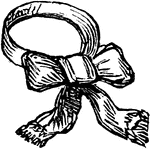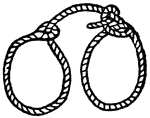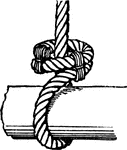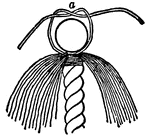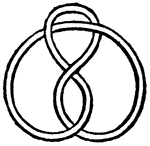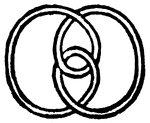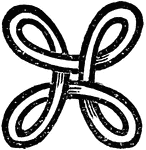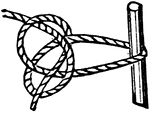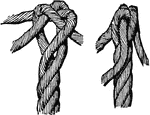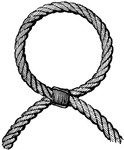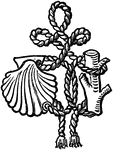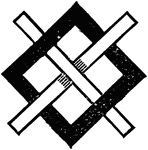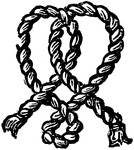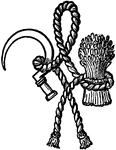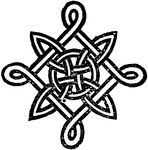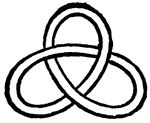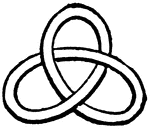The Knots ClipArt gallery offers 132 illustrations of different types of knots, showing detailed steps on how to handle the rope or thread and tie the knot. Although many of the knots included in this gallery have nautical applications, they are also used in many other fields.
Blackwall Hitch
"Blackwall -- Form a bight at the end of a rope, put the good of a tackle through the bight so that…

Blackwall Hitch
To tie a blackwall hitch, form a bight at the end of a rope, and put the hook of a tackle through the…

Double Blackwall Hitch
"Double backwall hitch -- Pass the end a twice round the hook and under standing part b at the last…

Cravat bow
"Plait the ribbon a distance from the end to allow for a streamer or bow end. Hold the plaits with the…
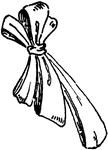
Uneven bow
"For the uneven bow, measure a long loop, plait, and hold with right hand. Opposite this, measure, plait,…
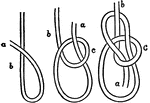
Bowline
"Bowline -- lay the end of a of a rope over the standing part b. Form with the b a bight c over a. Take…
!["Bowline on a bight -- The first part is made similar to the [bowline knot] with the double part of the rope; then the bight a is pulled though sufficiently to allow it to be bent over past d and come in the position shown...It makes it more comfortable sling for a man with a single bight." -Britannica, 1910](https://etc.usf.edu/clipart/58300/58352/58352_bowlinebight_mth.gif)
Bowline on a Bight
"Bowline on a bight -- The first part is made similar to the [bowline knot] with the double part of…

Carrick Bend
To tie a carrick bend, lay the end of one rope over its own standing part so as to form a bight. Put…
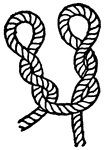
Cat's-paw
"Cat's-paw - Twist up two parts of a lanyard in opposite directions and hook the tackle in the eyes...A…
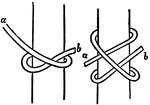
Clove Hitch
"Clove Hitch -- Pass the end a round a spar and cross it over b. Pass it round the spar and and put…

Clove Hitch
To tie a clove hitch, first pass the end 'a' around a spar, and cross it over 'b'. Pass it around the…
!["Diamond Knot -- The rope must be unlaid as far as the centre if the knot is required there, and the strands handled with great care to keep the lay in them. Three bights are turned up as in [the illustration], and the end of a is taken over b and up the bight of c. The end of b is taken over c and up through a. The end c is taken over a and through b. When hauled taut the strands are laid up again it will appear as in [the right illustration]." -Britannica, 1910](https://etc.usf.edu/clipart/58400/58443/58443_diamond-knot_mth.gif)
Diamond Knot
"Diamond Knot -- The rope must be unlaid as far as the centre if the knot is required there, and the…

Double Strand Knot
"Any knot, however complex, can be fully represented by three closed plane curves, none of which has…

Double Strop
"Double Strop -- Made with one piece of rope, the splice being brought as usual to the crown of the…
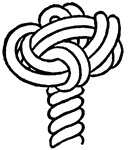
Double Wall and Double Crown
"Double Wall and Double Crown -- Form a single wall crowned; let the ends follow their own parts round…
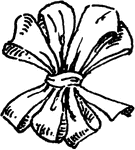
Rosette of even loops
"Measure all loops so they are of even lengths. Have the same number of loops on each side of the knot.…
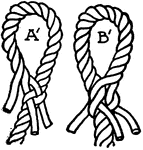
Eye-splice
"For making an eye splice, the end of the rope is unlaid and the strands are bent upon the body of the…
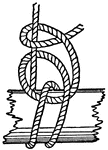
Fisherman's Bend
"Fisherman's bend -- Take two turn round a spar, then a half-hitch round the standing part and between…
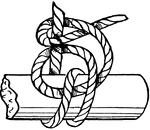
Fisherman's Bend
To tie a fisherman's bend, take two turns round a spar, then a half hitch round the standing part, and…
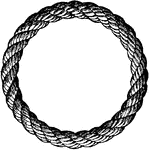
Grommet
"Grommet. Naut., a ring of rope used for various purposes, made from a strand laid three times round…
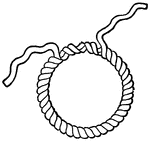
Grummet-Strop
"Grummet-Stop -- Made by unlaying a piece of rope of the desired size about a foot more that three times…

Half-Hitch
"Half-Hitch -- Pass the end a of the rope round the standing part b and through the bight." -Britannica,…

Inside Clinch
"Inside Clinch -- The end is bent close round the standing part till it forms a circle and a half, when…

Knot
A complication of threads, cords, or ropes, formed by tying, knitting, or entangling, which resists…
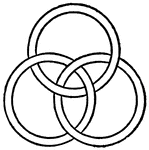
Knot
"Any knot, however complex, can be fully represented by three closed plane curves, none of which has…

Bourchier Knot
Also known as granny knot. A binding knot used to secure a rope or line around an object.

Bowline Knot
To tie a bowline knot, lay the end of the rope 'a' over 'b' so as to form a bight 'c'; pass the end…

Half-Hitch Knot
To form a half-hitch, pass the end 'a' of the rope around the standing part 'b', and through the bight.

Overhand Knot
The most common type of knot, the overhand is made by passing one end of a line over the line and around…

Reef Knot
A reef knot is formed by taking an overhand knot and repeating the overhand knot process (pass one end…

Square Knot
"This is much better than the granny knot, because it is easily untied, but will not loosen of itself."…
